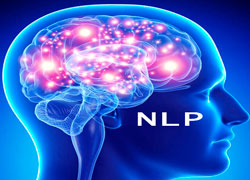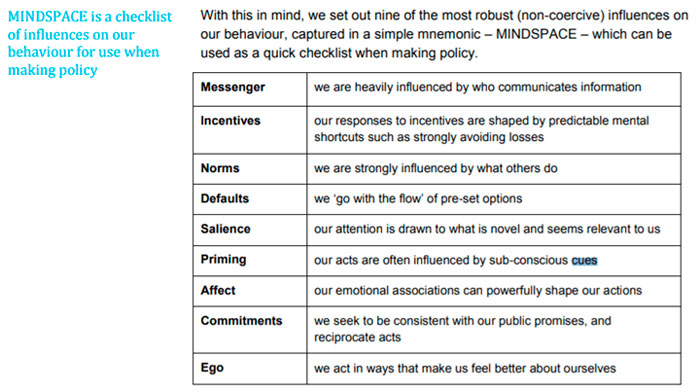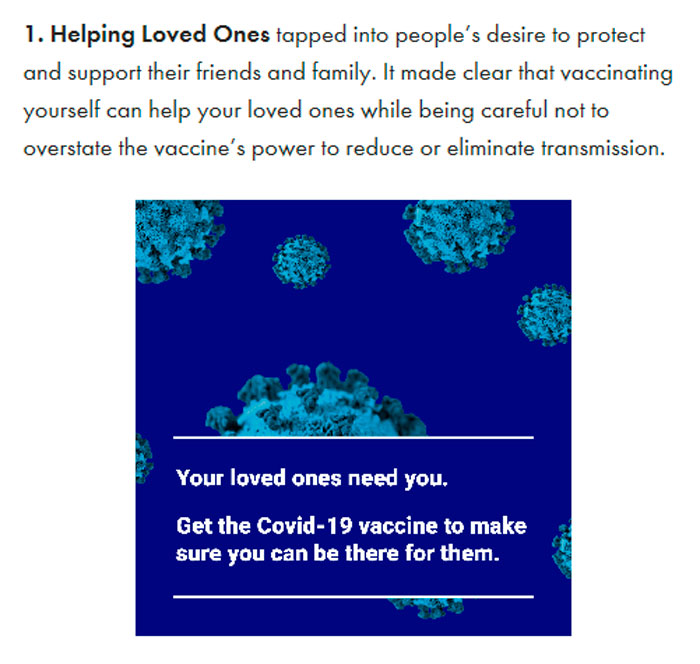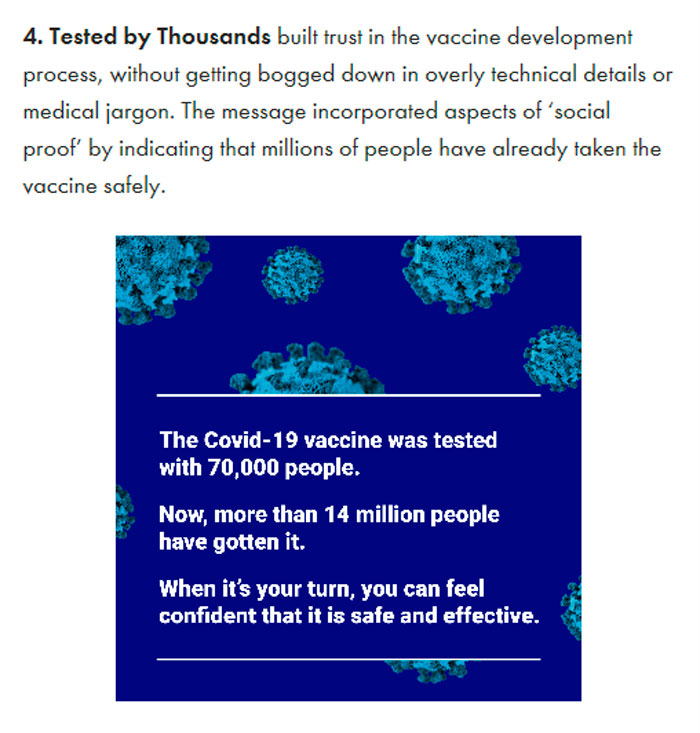MindSpace, Psyops, and Cognitive Warfare: Winning the Battle for the Mind
The last two years have seen a culmination of a nearly century-long effort to perfect social engineering and psychological warfare techniques in the Western world. Some observers have remarked that a significant portion of the population appears to be under a spell. They may be closer to the truth than they think.
two years have seen a culmination of a nearly century-long effort to perfect social engineering and psychological warfare techniques in the Western world. Some observers have remarked that a significant portion of the population appears to be under a spell. They may be closer to the truth than they think.
As previously reported by The Guardian and The UK Column, governments across the Western world—especially among the Five Eyes—have been using “Nudge Theory” and Neuro Linguistic Programming (NLP) to effectively change people’s behaviors without their conscious knowledge.
The purpose of this article is to provide an in-depth look at precisely how these psychological techniques work, as well as the main nodes tasked with weaponizing them. We will then consider how a precise understanding of how the methods are used can essentially allow people to neutralize them, as well as their future use.
Notable among the array of techniques used in the covid-19 pandemic response is Neuro Linguistic Programming (NLP). NLP includes the idea of “re-framing” people’s perception of reality by changing the context in which various situations or realities are viewed by individuals. Interestingly, the first book on NLP, The Structure of Magic, includes such chapters as “Becoming a Sorcerer’s Apprentice” and “The Final Incantation.”
Therapeutic techniques associated with NLP are often described as having magic-like qualities. While these techniques may be considered neutral and potentially very useful for clients wishing to resolve personal issues, they can by their very nature be weaponized and used to redefine people’s perception of reality. As we will see, by “re-framing” an individual’s perception and transforming their “linguistic model,” they may be convinced to make choices that they would not consciously make were a wider or alternative “context” presented.
Re-wind to the UK Institute for Government’s 2010 MindSpace discussion document and we find something akin to a twenty-first century “Sorcerer’s Apprentice” handbook. Commissioned by the UK Cabinet Office, MindSpace is filled with techniques that could be used to target what its authors refer to as “automatic processes” i.e. unconscious processes. The document reads like a “how to” on changing people’s thoughts and behavior patterns without their conscious knowledge or consent. As we will see “re-framing” techniques feature prominently in the form of the document’s “context” model of behaviour change. Today, we observe their application in virtually every sector of public policy-making.
Ostensibly a discussion document, the “About this document” section of the report describes its purpose as “exploring the application of behavioural theory to public policy for senior public sector leaders and policy-makers.” Hailing from several of the UK’s “elite” institutions, including London Imperial College, Oxford, and the London School of Economics, its authors are some of the leading experts in the fields of social psychology and behavioural science.
On page 14, the MindSpace authors outline the basic outlook and insights guiding their approach to “behaviour change” by making the distinction between “automatic processes” and “reflective processes”:
“The contrasting model of behaviour change focuses on the more automatic processes of judgment and influence – what Robert Cialdini calls “click, whirr” processes of mind. This shifts the focus of attention away from facts and information, and towards altering the context within which people act. We might call this the “context” model of behaviour change. The context model recognises that that people are sometimes seemingly irrational and inconsistent in their choices, often because they are influenced by surrounding factors. Therefore, it focuses more on “changing behaviour without changing minds.” This route has received rather less attention from researchers and policymakers.”
Page 14 of the “Introduction” section includes a chart outlining the characteristic differences between the two systems:

“Changing behaviour without changing minds” is in many ways similar to NLP “re-framing” techniques. Considering its significance and potential future use, a few words on the nature of NLP should be added.
The Structure of “Magic”
Since its foundations were laid in The Structure of Magic by John Grinder and Richard Bandler, NLP practitioners have described NLP as having magic-like qualities. NLP is usually framed as a question of expanding a client’s ability to deal with the real world by transforming the linguistic models through which they interface with the world. NLP practitioners point out that none of us directly interact with the real world, but rather do so in accordance with the models that we have ourselves developed to map the world. Said otherwise, our actual experience of the world and the models or maps that we create based on that experience are not identical. In The Structure of Magic the authors use the example of an actual map, which is not the actual territory, but only a representation of it. The map is useful to the degree that it resembles the actual territory, but it is not the territory. From there, the authors list three basic ways that people may misshape their own maps of reality: deletions, distortions, and generalizations.
By helping the client to change his/her map—formed linguistically—an NLP practitioner can help change how a person responds and behaves under various circumstances.
As an initial practical example of the potential effects, one can change the frame of reference in respect to time: someone told they have one hour to write a paper will likely have a significantly different response than if they are told they have one week to write the same paper. Time becomes a critical frame of reference.
John Grinder gives the example of a session with a client who complains: “My son makes me so angry when he comes home late.” The mother is always upset when her son arrives home late. There seems to be no option that doesn’t lead to some kind of distressed state. So the therapist may ask: “Is there a time when your son came home and you weren’t angry?” By asking the client to identify some time where they didn’t have the same reaction, they are being challenged to retrieve new information from their “deep structure” and integrate it into a new expanded model. The client is creating choice where it previously did not exist.
In NLP terms, the “surface structure” (My son makes me so angry when he comes home late) suggests that their son coming home late, regardless of any context, is the cause of their anger and distress. In that limited surface structure no alternative choice or response exists in the event their son arrives home late. However, using a series of questions the therapist can challenge the client to refine their own model in order to create a more adaptive one. So cases included in the client’s “deep structure” are brought to the surface i.e. perhaps coming home late was not the actual problem: maybe it was the fear of their child being out late after dark, or a feeling of disrespect, a refusal accept the maturation of their child, or a feeling of neglect? In a word: the client is challenged to create “well-formed” sentences which include the deletions or reject the generalizations, distortions. In a word: the NLP expert can help clients re-evaluate their linguistic map, allowing for a change in their potential response or choice in various situations.
With these basic NLP techniques or “incantations,” patients are provided with new opportunities to reframe their experience. However, this “reframing” of the world according to alternative linguistic models also means that their thoughts and behaviours may be altered either for better or for worse. The naturally neutral nature of “re-framing” techniques may be either more accurate or less accurate, or even completely false, depending on how one “re-frames” their perception of reality.
A relevant example would be recent covid-19 messaging slogans like “Stay Home. Save Lives.” While a seemingly simple and straight-forward message, upon further examination the seemingly simple surface structure “Stay home. Save lives” has a very specific “deep structure.” The statement includes what in NLP terms could be considered “deletions” or simply “generalizations.” For example, if one tries to invert or explore the statement “Stay Home. Save Lives” and all its possibilities, one finds the slogan has only one alternative: “leave your home and murder people.”

The linguistic model frames reality as a set of two choices: making the conscious decision to save lives or take lives. There is no nuance, no exceptions for young and healthy people, or specifications for people at higher risk of becoming ill. According to the “Stay Home. Save Lives” model, one can effectively murder people simply by choosing to leave their home.
The reframing of basic everyday scenarios in order to elicit the maximum fear response with almost scientific precision is not by chance. Social engineers understand that by framing questions in a certain manner such that they directly target “automatic motivations,” basic evolutionary mechanisms can be activated and weaponized.
In fact, as the UK Scientific Advisory Group for Emergencies (SAGE) March 22nd, 2020 board meeting summary documents, the perception of personal threat and danger in respect to covid-19 had to be increased in order to increase compliance with covid-19 social-distancing measures. Point 2, under the “Persuasion” option of the SAGE meeting minutes reads as follows:
Perceived threat: A substantial number of people still do not feel sufficiently personally threatened; it could be that they are reassured by the low death rate in their demographic group (8), although levels of concern may be rising. Having a good understanding of the risk has been found to be positively associated with adoption of COVID-19 social distancing measures in Hong Kong (10). The perceived level of personal threat needs to be increased among those who are complacent, using hard-hitting Evaluation of options for increasing social distancing Page 2 emotional messaging. To be effective this must also empower people by making clear the actions they can take to reduce the threat.
March 22nd, 2020 SAGE Meeting Minutes
While the SAGE board is a UK government organization, various other UK agencies and outlets turn out to be at the very center of the covid-19 messaging campaigns across the entire Five Eyes i.e. Australia, Britain, Canada, New Zealand, and the USA. Specifically, the Behavioural Insights Team (BIT) appears to be one of the crucial and most effective nodes in this psychological warfare web, operating under the guise of crafting effective covid-19 messaging and using MindSpace “behavioural insights” to shape public policy.
Entering MindSpace
With some background knowledge of how the latest research into social psychology and behavioural science is being applied, let us take a closer look at exactly how specific knowledge of MindSpace and its particular “behavioural insights” can vastly transform our own ability to not only defeat present psychological warfare operations, but may also prevent future ones.
As we have said, the main focus of MindSpace is centered on the crucial distinction between “reflective processes” and “automatic processes”:
The two systems have different capabilities: the reflective mind has limited capacity, but offers more systematic and “deeper” analysis. The automatic mind processes many things separately, simultaneously, and often unconsciously, but is more “superficial”: it takes short-cuts and has ingrained biases. As one academic source explains, “once triggered by environmental features, [these] preconscious automatic processes run to completion without any conscious monitoring.”
“Without any conscious monitoring” means if certain messages are framed in such a manner that they bypass conscious processes and speak directly to the automatic processes, then by the nature of the evolutionary mechanisms built into us (for example, fight or flight responses), humans are hard-wired to respond without having to resort to self-conscious decision-making. An example of triggers for our automatic processes and motivations are the sudden appearance of existential danger, or someone threating our children: our bodies and minds are hard-wired to respond; our adrenaline spikes; fight or flight responses kick in whether we wish them to or not. Furthermore, regardless of whether the perceived threat is real or not, the perception of such a threat has essentially the same effect on our built-in mechanisms and “automatic processes.”
In this light, consider the fact that Mindspace is essentially a document discussing the vast array of techniques to trigger and direct our automatic motivations with scientific precision and with the least amount of intervention by our “reflective processes.”
Page 18 in the “User’s Guide” section presents a checklist of influences on our behaviour:

So today, it is believed that by “re-framing” reality and the narratives people live their lives by i.e. “the context model” and “nudging” people from the standpoint of various behavioural insights found in MindSpace, including natural “defaults,” “norms,” “cues,” “priming”—all of which target the automatic processes—it’s believed that people can be “nudged” into making choices they otherwise would not make. Morever, it’s believed that because behaviours and thoughts will be changed “below-board” i.e. using automatic motivations, even if people know their ideas have changed, they won’t necessarily be able to know how or why.
In a word: the whole art of “nudging” and “re-framing” lies in crafting messages that speak directly to our automatic processes with the limited intervention of our “reflective processes.” For, the latter instantly slows down the “click whirr” response of automatic processes and leads to more questions.
Of course, MindSpace uses benign examples to demonstrate how its “non-coercive” influences work, from putting a vegetable option first in school cafeterias in order to improve diet among children, to creating more smoke-free zones using distance. However, when looked at more closely, it is precisely the “automatic motivations” that can be triggered and weaponized within various contexts, especially in times of perceived crisis or threat.
Having discussed the basic outlines and intentions behind MindSpace, we can now fast-forward to the application of these techniques in the recent two years. Enter the Behavioural Insights Team (BIT), also known as the “Nudge Unit.”
The BIT: “Nudging” Towards a Brave New World
According to its website, the Behavioural Insights Team (BIT) is jointly owned by “the UK Cabinet Office, the innovation charity Nesta and BI employees.” Not surprisingly, the UK Cabinet Office is the same institution that commissioned MindSpace several years earlier.
The Behavioural Insights Team (BIT) appears to be one of the most effective nodes in this psychological warfare web. Its website states that they have offices across the entirety of the Five Eyes, as well as France.
Known as the “Nudge Unit,” it has pioneered “nudge theory” as a means of changing people’s behavior in order to implement economic, public, environmental, and health policies. As we have discussed, nudging includes recognizing certain “default” positions that people have and “re-framing” the context of perceived choices according to various specifications. By their nature, these techniques involve Neuro Linguistic Programming where “anchors” and “cues,” “priming” and “re-framing” are utilized. These techniques have all been honed after decades of research such that an unknowing citizenry bombarded with a panoply of techniques meant to trigger their automatic motivations should hardly be able to recognize how these operations are being deployed across vast parts of the world. And yet, this is exactly what teams like the BIT are involved in.
As reported by the UK Column, two teams were identified as leading the covid-19 response in Britain:
The first is the team at Imperial College led by Neil Ferguson, which claims to be able to use its computer models to forecast the spread and impact of the disease. The second is the army of behavioural “scientists” who have been ‘nudging’ us at every opportunity into making decisions which favour the preferred options set by global policy makers.
While the role of London Imperial College (LCI) in producing the doomsday models to justify the complete lockdown of the Western world is beyond the scope of this essay, it should be pointed out that the LCI has played a role very similar to that of the UK’s East Anglia University managing the statistical data used to generate “climate change” doomsday models, which are then cited by the UN and other government bodies the world over. Of interest for this report is the latter team: the “army” of behavioural scientists (of which the BIT appears to be a top-tier division).
Take for instance the BIT’s study of “Four Messages that Can Increase the Uptake of COVID-19 Vaccines” published on March 15th, 2021. The most effective message for increasing vaccination uptake was “protecting loved ones”:

Having studied the MindSpace findings on “automatic motivations,” the top-ranked message should come as no surprise: if someone is faced with the choice of “protecting loved ones” from an existential threat—whether real or perceived—the decision is automatic. Additionally, from the standpoint of “defaults” (losses looms larger than gains), most empathetic human beings will not want to risk losing loved ones—a major loss—for the sake of say attending some social function—a minor gain. Moreover, they will be willing to make great sacrifices in order to avoid even larger losses, whether potentially real or simply perceived.
As readers look over each of the four messages they should consider the fact that none of the messages themselves essentially require any sort of serious reflective process or conscious evaluation. Even the use of phrasings like “according to most experts” or “research shows” are themselves not scientific statements, but appeals to group think.
In reality, no honest scientist argues over the validity of their work or research by saying “most scientists agree.” Scientific truth and fact are never the product of consensus. And yet we have seen a very steep rise in the use of group-think arguments for promoting public policy, from the idea that “97% of scientists agree on global warming” to “thousands of healthcare workers are getting vaccinated.” Virtually all covid-19 public messaging is crafted to appeal to precisely the human tendency for group think and adherence to “norms.”
Consider the next three most effective messages.
Number two was covid-19 vaccination programs have the “approval” of healthcare workers.

Number three lists “Getting Lives Back,” but specifically prescribes not making promises that life will ever go back to “normal.”
The fourth and final most effective message is a simple and outright appeal to group-think i.e. “social proof.”

None of these messages require critical faculties. In fact, they discourage them. They are specifically crafted to bypass conscious processes and directly speak to “automatic processes.”
Conclusion
As we mentioned at the beginning of this report, these latest developments in psychological warfare represent a culmination of a century-long effort to perfect social engineering in the Western world. While we discussed the application of these techniques in respect to covid-19 messaging, these techniques can be seen in public-policy messaging across virtually every sector of society, especially concerning the environment and economic policy.
When considering the current and future use of these kinds of techniques for “behaviour change,” let us remember the words of an early social engineering enthusiast and descendent of one of England’s oldest imperial lines, Lord Bertrand Russell. Over a half a century ago, Russell remarked:
The social psychologists of the future will have a number of classes of school children on whom they will try different methods of producing an unshakable conviction that snow is black. Various results will soon be arrived at. First, that the influence of home is obstructive. Second, that not much can be done unless indoctrination begins before the age of ten. Third, that verses set to music and repeatedly intoned are very effective. Fourth, that the opinion that snow is white must be held to show a morbid taste for eccentricity. But I anticipate. It is for future scientists to make these maxims precise and discover exactly how much it costs per head to make children believe that snow is black, and how much less it would cost to make them believe it is dark gray.
Concluding his optimistic musings on the future of social engineering techniques, Russell writes:
Although this science will be diligently studied, it will be rigidly confined to the governing class. The populace will not be allowed to know how its convictions were generated. When the technique has been perfected, every government that has been in charge of education for a generation will be able to control its subjects securely without the need of armies or policemen.
Bertrand Russell – The Impact of Science on Society (1951)
While much of the applied research in the fields of social psychology and behavioural science appears to have enabled social engineers to imbue their messages with an almost spell-like quality, as even the founders of NLP described in The Structure of Magic—these “incantations” and “nudges” have a very definite structure. They are formulaic and therefore easily identifiable once a name has been put on them.
Since the would-be sorcerer’s apprentices of today appear to have no plans of letting up on the application of these techniques across virtually every sphere of thought and action, the simple act of putting a name on them may be the essential step to “breaking the spell.” For, the act itself essentially neutralizes the “nudges” by turning them into conscious objects. Suddenly, “the populace” is “allowed to know how its convictions were generated.”
As MindSpace authors mentioned, automatic processes can go on operating unimpeded and without any monitoring by the conscious self until completion. In the case of an ever-changing crisis-management response and the organization of society around “pandenomics,” those simply waiting for the spells to wear off may find themselves disappointed, and neck-deep in crises far beyond the control of a twenty-first century sorcerer’s apprentice. The key to breaking the spell is naming it. Once a name is put on these “structures,” forcing them out of the automatic processes and into conscious processes, the programs essentially stop running at their automatic “click, whirr” speed. Unconscious thoughts—the “deep structures”—are brought into view of other analytical processes—essentially gumming up the works. Suddenly, the “magic” disappears. The smooth and well-oiled thoughtless automatic flight forward reaches a screeching halt.

The spell is broken.



